EK: It’s a well-known fact that I am obsessed with salt and even collect it. It is the one souvenir that I always bring back from any area that I visit. I have red salt, black salt, Himalayan pink salt, grey salt, all kinds of white salt—coarse and fine—truffle salt—I even make my own flavored salts for gifts like my Hibiscus Finishing Salt…you get the picture!
EK: But my favorite salt of all time is Fleur de Sel from France. And as much as I love Fleur de Sel, I had never visited the salt marshes of France in either the Guérande region or the Camargue region, and it had been on my bucket list for a long time…
AU: Honestly, knowing you are such a Francophile, I’m actually SHOCKED you haven’t been to the salt marshes and gotten an up close look at your favorite ingredient!
EK: That’s right! And, a couple of weeks ago, I crossed it off my list when I traveled to La Baule to visit and learn about the summer salt production in Guérande.

EK: La Baule, (officially La Baule-Escoublac), is a seaside resort town that was formerly part of Brittany and is now located in the Loire-Atlantique region (western France). The cultural identity remains strongly Breton—in language, architecture, food and drink—especially crêpes, hard cider, salted butter caramel, seafood—and salt from the nearby Guérande salt marshes.

EK: I am lucky that my first experience seeing the salt marshes in France was in the smaller Guérande area where everything is harvested by hand by a group of 400 Paludiers. A Paludier is the French name for the farmer who takes care of their salt marsh and harvests the salt. Most of the Paludiers are men, but in this region, 10% percent are women.

EK: It is a beautiful centuries-old, hand-made process where in the months of June through September, every grain of salt is created when the delicate balance of the sea, the sun and the wind is just right. It is nurtured and harvested by the salt farmers and if the timing is right, they have a good day. If it rains, or the salt is not raked in time, the salt returns to the sea.
AU: It’s crazy to me that an ingredient that is so ubiquitous rests in the fragile balance of nature/climate/weather so much! I had no idea!!
EK: It is SO interesting because the way that the Paludiers work is very traditional, very artisanal. The process is the same as it has been for hundreds of years. They prepare each of the salt beds, monitor water levels in the basins, control the flow of water, master reading and understanding signs of nature, and harvest the salt with finesse and expertise.

EK: It is both simple and complex. Sea water flows through a network of basins and as it flows, it gradually evaporates through a combination of sun and wind. The amount of sea water that fills the individual salt pans is controlled by gravity and the “gates” that let more water in, or stop the flow of water.
The gates are made from a piece of slate and stop the flow, or allow water to fill the basins. When they want just a little more water, they control the flow by picking vegetation that grows near the marsh (like a branch from a plant) and sticking it into one of the holes to reduce the amount of water that comes rushing out.
AU: It’s fascinating because you would think there would be some type of modernization to the process over the years, with so many advances in technology and machinery… but no… I can just hear an old French man saying “this is the way we’ve always done it!” hahaha
EK: Exactly! And it’s a good thing! The salt harvest is dependent on both weather and time, and must be harvested everyday in the summer months. It all comes down to the fine balance between the amount of sea water, the sun and the wind.
The Paludiers are all independent farmers. If you buy French sea salt, you are probably familiar La Baleine. The same company, La Baleine Guérande, collaborates with more than 90 independent Paludiers to supply them with the natural salt for their various retail and wholesale salt products like the photo of all my salt souvenirs at the top of this post.
Just like all farming, if the weather cooperates and it is a good year, it can be lucrative; if there is a lot of rain like there was last year, it is a tough business.
EK: There is nothing mechanical or automated about it, and as such the harvested salts are verified by the PGI which is short for L'Indication Géographique Protégée. In case you’ve never heard of it, the Protected Geographical Indication (PGI) was created in 1992 as part of the European quality policy for agricultural and food products to protect and recognize the quality, authenticity and local heritage of traditional and artisanal products.
AU: PGI is the French version of the Italian DOP which stands for Denominazione di Origine Protetta (Protected Designation of Origin). It’s what I always look for on the label when I want to buy REAL San Marzano tomatoes or really nice dried pastas.
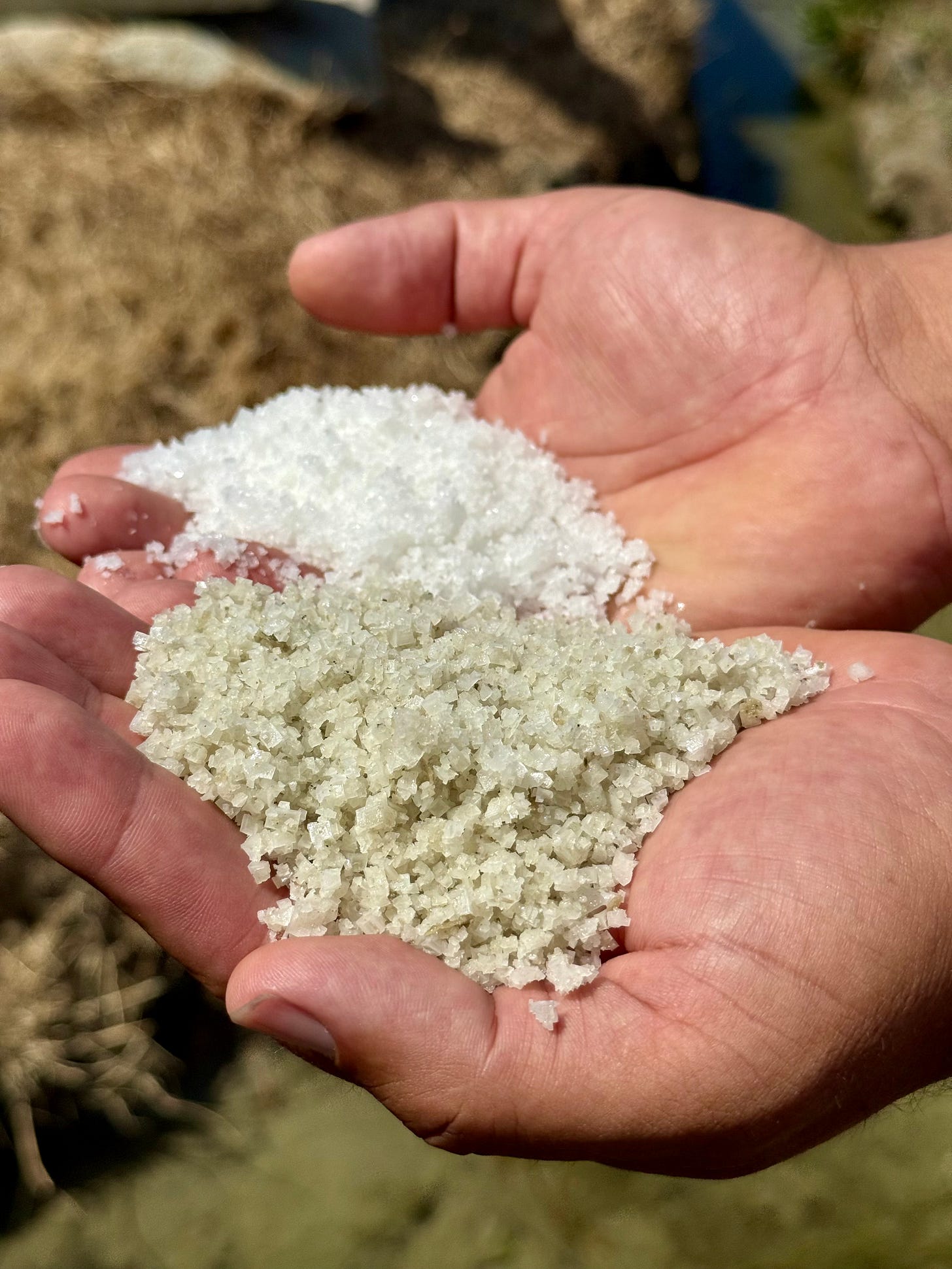
EK: The larger Sel Gris (grey sea salt) represents the majority of the harvest and is coarser and darker in color. The color of the salt comes from being close to the dark clay bottom of the salt marsh and it contains many trace minerals and is high in potassium, magnesium and calcium.
The Fleur de Sel (flower of salt) represents the small white crystals of salt that float on the surface. These precious crystals start to form on the top of the water as the afternoon sun sets. If you don’t capture the Fleur de Sel at the end of the day, it will sink and become part of the larger coarser salt.
AU: Wow! And that’s why it’s so coveted! It’s truly the finest of the sea salts!!

EK: Guérande is in the southwest of France about an hour by train from Nantes. We flew to Paris and took the TGV to La Baule where we stayed at a small charming hotel called Saint Christophe.
The location was perfect, a few blocks from both the beach, great shopping and one of the best food markets that I’ve seen in France.
AU: And hun, you’ve seen ALOT of food markets in France, so that’s high praise!

EK: From my first breakfast, I noticed that the bread at the hotel was exceptional and it took a few more days of me “experimenting” with the bread and pastry in the morning to ask where it came from.
The bread that the hotel serves is from the Chef Karl Lefortier from the local Boulangerie Maison Airaud. I have eaten a lot of bread all over the world and this was some of the best bread that I have ever tasted. Both the flavor, and the texture was on point.
Chef Karl is a master baker and lucky for us, he gave us a demo on the importance of salt in bread. To prove his point, he let us taste the same baguette, made with and without the local salt.
Boy, what a difference! Salt affects both the taste and texture of the bread and Chef Karl uses only the Guérande sel gris in his bread. The bread without the salt tasted like nothing—the closest thing I could identify was unsalted matzoh—and the outside crust lacked the crustiness of the bread with salt. The salted baguette had a sweet yeasty flavor with a denser, chewier crumb and a crunchy crust. With a bit of French butter and a pinch of Fleur de Sel, it was the best part of the meal.

EK: Needless to say, because the Fleur de Sel was abundant, and the bread and butter was so good, I ate more bread, butter and Fleur de Sel than anything else!
And that made me think that instead of pining away for the butter of Brittany enrobed with grains of Fleur de Sel, I would make my own butter with Fleur de Sel and see how it compared.
AU: Necessity is the mother of invention! We’ve always said that salt makes everything better… but THIS salt makes everything EXCEPTIONAL!
EK: Yes! And spoiler alert: My homemade butter was fantastic. Stay tuned for next week when I will share my Fleur-de-Sel-Studded Butter recipe!!

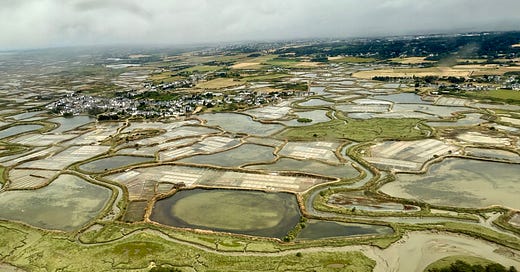



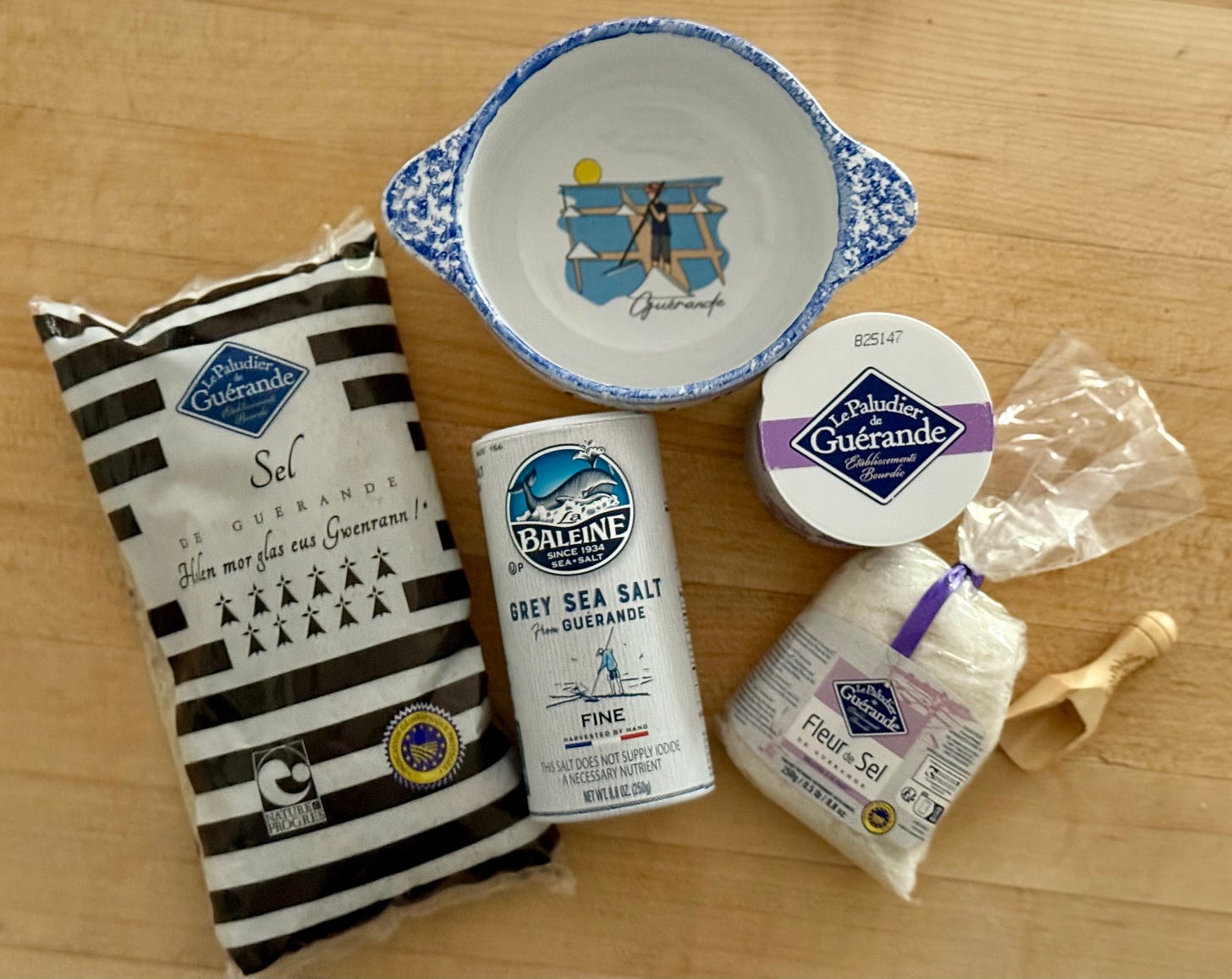
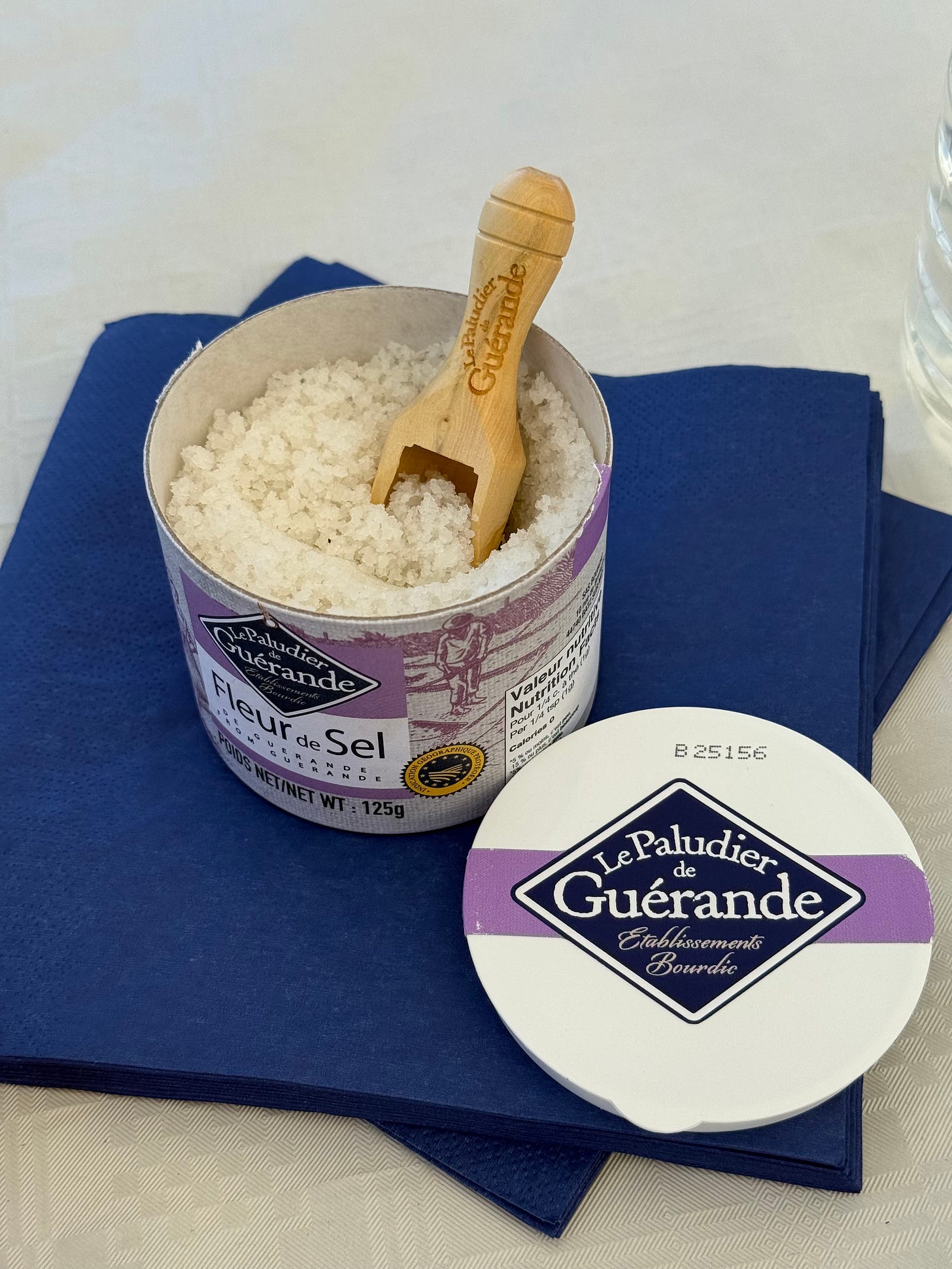
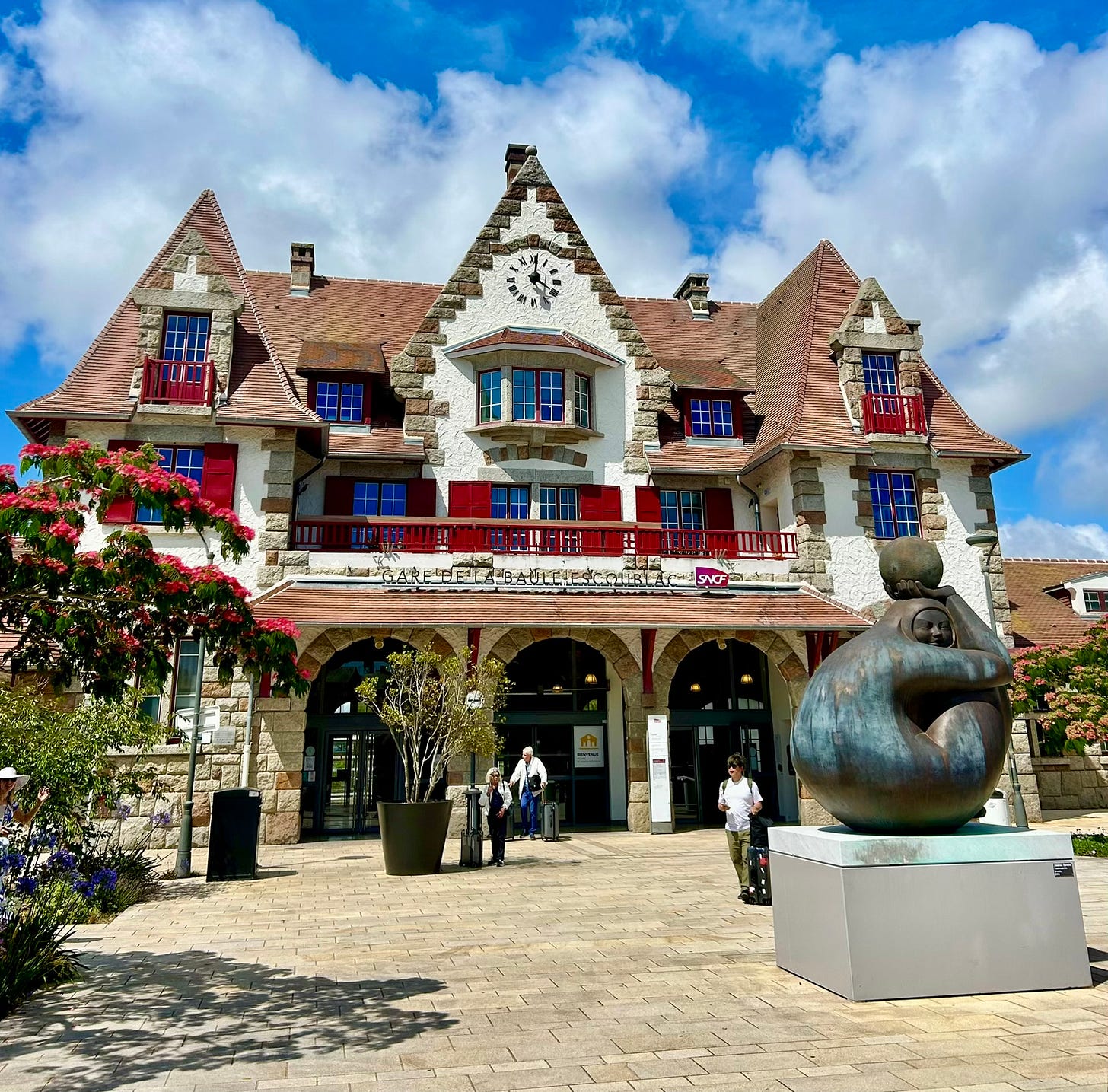
This was so much fun to read!
Thanks Josh!! It was a really great trip!!